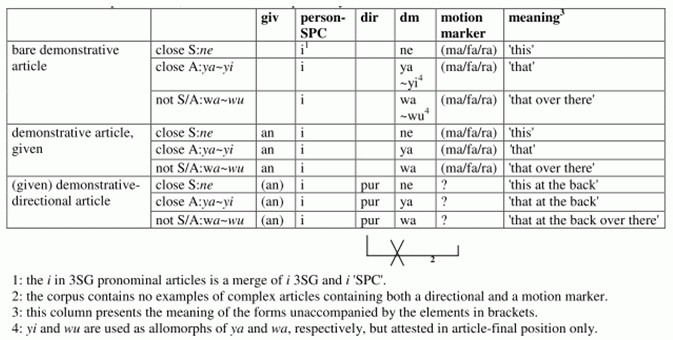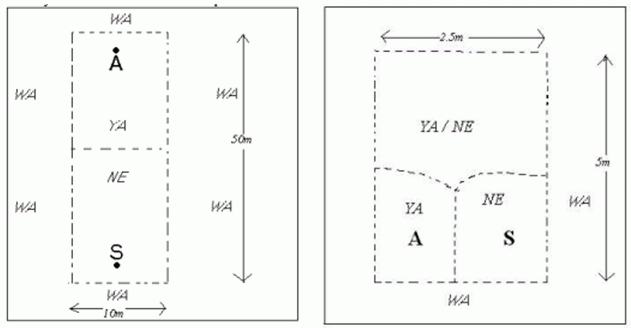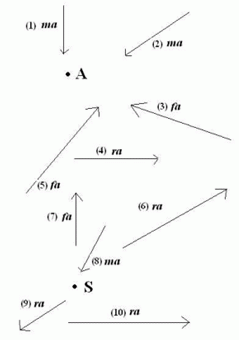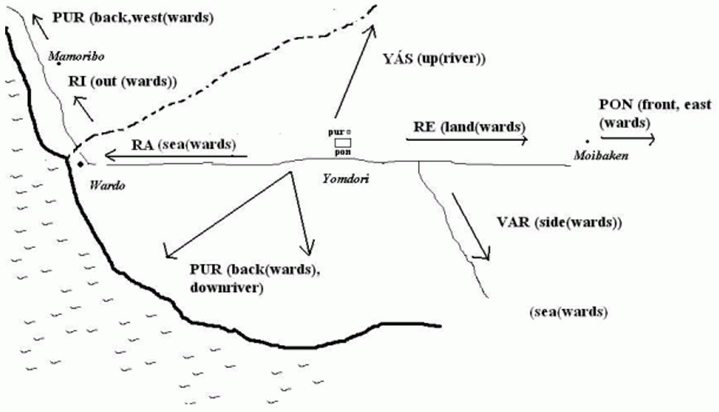Space
This section highlights some of the most fascinating aspects of the way in which Biak speakers refer to entities (persons, animals or objects) in their environment. As a starting point, consider the following table, which summarizes the structure of Biak complex articles:

The table shows that a word like an-i-ne-ma is a possible Biak word, consisting of a marker of givenness an-, a specificity marker i, a demonstrative element ne and a motion marker ma. It could be translated into English as ‘the one here you know about who is coming towards us’.
In this section we will look at some of the elements that this Biak complex article consists of, and also discuss the directional markers (given in the third (or fifth) column). It should be noted that directional, demonstrative and motion markers pop up at several places in the Biak grammar, not only as part of the complex articles. For reasons of brevity, this description takes the complex articles as its focus and starting point, as illustration of a system in which reference to space plays a major role.
Demonstratives
Within the demonstratives, the language makes a threefold division between:
- ne ‘here’, used for referents close to speaker
- ya ‘there’, used for referents close to the addressee
- wa ‘over there’, used for referents outside the shared area of speaker and addressee.
This is illustrated in the following two figures, where S stand for speaker, and A for Addressee. In the left figure, the speaker and addressee are located at opposite sides of a field, viewing each other. The terms ne,ya and wa refer to the demonstrative elements that are used by the speaker when pointing to a bicycle posited in the respective area. The Figure shows, for example, that the element ya is used when the cycle is conceived of as being closer to the addressee than to the speaker, e.g. in the expression sepeda ine ‘this cycle’. As soon as the object is located outside the shared area of speaker and addressee (indicated by the outer dotted lines), however, the speaker uses wa, as in sepeda iwa.

In the right figure, we see a situation where S and A are sitting next to each other, and both face in the same direction. Note that the scale is smaller here, as the focus is on an area of approximately 2,5 to 5 meter. Again, it is clear that ya is used for objects close to the addressee, ne for objects close to the speaker, and wa for objects outside the area between speaker and addressee. Compared to the situation depicted in the left picture, there’s a relatively larger area where a speaker can conceive of an object either as close to himself, expressed by the use of ne, or as close to the addressee, expressed by the use of ya.
Motion markers
Now consider the next figure, which again shows a speaker and an addressee at opposite sides of a field. Other than in the situations above, the speaker refers to a moving entity, in this case a person. The fact that the person is moving, makes that Biak speakers will generally make use of motion markers in referring to this object.

As is apparent from the figure above, the element ma is used for movements in the direction of the speaker, as is illustrated by movements 1,2 and 8. Fa is used for movements in the direction of the addressee and not in the direction of the speaker. Therefore, persons moving in the directions of 3, 5, and 7 are referred to by means of fa (as in mansar iyafa ‘that old.man going towards there’), while movements 1 and 2 – conceived of as heading (also) towards the speaker - are expressed by ma. Moving neither towards the speaker nor towards the addressee, finally, is expressed by ra ‘towards over there’.
Directionals
The following figure is a sketch of the village Yomdori, where much of the fieldwork on the Biak language was conducted. The Biak morphemes, written in capitals, represent directionals that are used to refer to entities (animals, objects, persons) moving in the direction indicated by the accompanying arrows. Crucially, which morpheme is used is dependent not only on the position of the object that is referred to, but also on the position of the speaker. The morphemes indicated in the figure, for example, can be used when the speaker is located in the village of Yomdori, e.g. in the house depicted in the centre of the figure.

The sketch above illustrates very well how it is the natural environment that provides, as it were, the axes that guide the use and interpretation of Biak directionals. An expression like rum i-pur-wa house 3sg.spc-back-over.there ‘that house at the back over there’ means that the house is located in a ‘backward’direction compared to the position of the speaker. Dependent on the natural environment, this backward may indicate a downriver location (southern part of the picture), or a westward location (western part of the figure).








